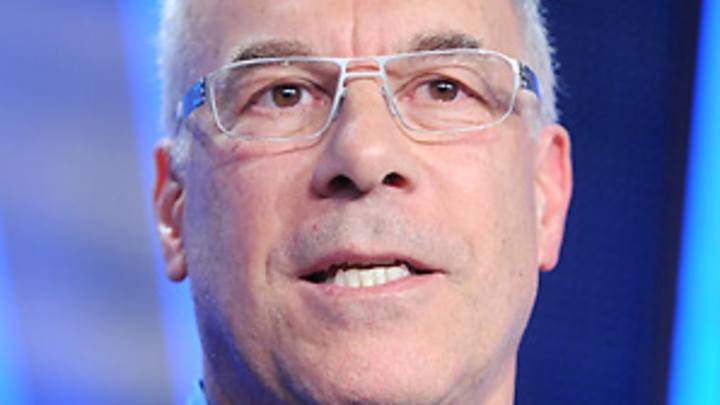NFL flame burns a little dimmer with passing of NFL Films' Sabol


It's not that a film record of the NFL never existed before Ed Sabol and his son Steve founded what would become NFL Films. Footage goes back to the days of Bronco Nagurski and Don Hutson in the 1930s and even Red Grange in the 1920s. But with the Sabols filming, editing, producing and writing the scripts for highlight packages,showcasing the NFL was transformed from a glorified newsreel to near art.
"We see the game as art as much as sport," Steve Sabol told The Associated Press when his father was inducted into the Pro Football Hall of Fame in 2011.
And Steve Sabol, who died Tuesday at 69 after an 18-month fight with brain cancer, incorporated a blend of creativity, football knowledge and humor that could bring all the elements together. He won more than 30 Emmys for writing, cinematography, editing, directing and producing.
Although NFL Films, which started as Blair Motion Pictures before the NFL purchased the enterprise in 1965, made its reputation by putting microphones on players and coaches (most famously the Kansas City Chiefs' Hank Stram in Super Bowl IV) and by utilizing cutting-edge slow-motion technology, Steve Sabol's skill as a writer should not be overlooked. He penned such memorable lines as NFL Films' obituary for coach Vince Lombardi:
"Lombardi, a certain magic still lingers in the very name. It speaks of duels in the snow and November mud... He remains for many the heart of pro football, pumping hard right now."
And for the Al Davis/John Madden Oakland Raiders of the 1970s:
"The autumn wind is a pirate. Blustering in from sea with a rollicking song he sweeps along swaggering boisterously. His face is weather beaten, he wears a hooded sash with a silver hat about his head ... The autumn wind is a Raider, pillaging just for fun."
When accompanied by deep-voiced narrator John Facenda (often called the "Voice of God"), Sabol's words and footage were compared by one observer to the D-Day landing.
More recently NFL Films has put together the successful Hard Knocks series for HBO and chronicled all 46 Super Bowls under the banner America's Game, which features interviews with key players and coaches blended with highlights of the season's major moments. Steve Sabol also helped start the NFL Network.
Salon.com wrote, "NFL Films is the greatest in-house machine in pro sports history."
The Sabol story began simply when Ed received a movie camera as a present and began filming Steve's high school games in Philadelphia and his college football action at Colorado College. In 1962, Ed put down $4,000 for Blair Motion Pictures (named for his daughter) to film the NFL Championship Game at Yankee Stadium between the Green Bay Packers and New York Giants. The game was played under brutal conditions, with temperatures in the teens and 35 mph winds battering the field.
Despite the weather, Blair produced enough usable footage for a 30-minute highlight film. NFL bigwigs, particularly Commissioner Pete Rozelle, were impressed. By 1965 the league had purchased the operation and renamed it NFL Films.
Most important, the Sabols had the backing of perhaps the two most important men in the game: Bears owner/coach George Halas and the Packers' Lombardi. Halas called NFL Films "the keepers of the flame" and Lombardi granted NFL Films unprecedented access, particularly during the 1967 season, Lombardi's last as coach of the Packers.
In the days before ESPN, nightly highlight shows and the Internet, NFL Films became a fan's ticket to the entire league. A weekly highlight show of every NFL game from the previous week -- narrated by Pat Summerall and Tom Brookshier -- was must-see TV. When Monday Night Football made its debut in 1970, the halftime highlight package narrated by Howard Cosell was one of MNF's most popular features.
Steve Sabol did everything at NFL Films but compose the music as Sam Spence, Dave Robidoux and Tom Hedden took care of the background scores. He introduced Super Bowl films, interviewed current and former players and helped write the scripts for many specials and annual reviews. He produced a highlight film for every NFL team, even those that finished at the bottom of the standings. Sabol somehow found a way to make even a 2-14 outfit sound like it was on the brink of championship contention.
As a sports filmmaker, perhaps only the late Bud Greenspan produced as long-lasting a body of work as Steve Sabol. But Greenspan viewed the Olympics with a non-critical eye and lacked Sabol's sense of humor. He would never produce a series of Olympic bloopers as Sabol often did with the NFL's most bizarre and unusual plays.
At the time of Sabol's death, NFL Films was making $50 million in annual revenue and featured a state-of-the-art Color Negative Processing Lab in Mt. Laurel, N.J. The lab contains more than 100 years of football history and is to the NFL what the Library of Congress is to the U.S. government.
Steve Sabol's work was not perfect. The Super Bowl V film of the Baltimore Colts' 16-13 last-second win over the Dallas Cowboys shows a side-angle view of a Jim O'Brien kick that was actually an extra point from earlier in the fourth quarter and not the game-winning 32-yard field goal. Although he was able to get interviews with most of the game's greats, Sabol was unable to persuade four-time Super Bowl-winning quarterbacks Terry Bradshaw and Joe Montana to participate in the America's Game series.
But the former art history major never forgot that football was a game and he enjoyed the heck out of it.
For a special on the stars of the 1960s, Sabol wrote: "In the 1960s the NFL had many superstars but only one superman" as the footage showed Cleveland Browns running back Jim Brown run over, run past and jump over defenders.
The NFL's flame now burns a little dimmer with the passing of Steve Sabol, its celluloid superstar.
